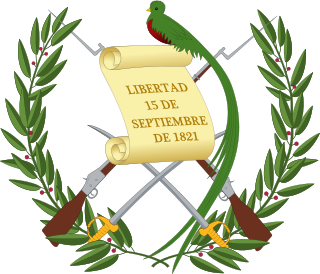
Carlos Castillo Armas was a Guatemalan military officer and politician who was the 28th president of Guatemala, serving from 1954 to 1957 after taking power in a coup d'état. A member of the right-wing National Liberation Movement (MLN) party, his authoritarian government was closely allied with the United States.

The 1954 Guatemalan coup d'état was the result of a CIA covert operation code-named PBSuccess. It deposed the democratically elected Guatemalan President Jacobo Árbenz and ended the Guatemalan Revolution of 1944–1954. It installed the military dictatorship of Carlos Castillo Armas, the first in a series of U.S.-backed authoritarian rulers in Guatemala.

General José Miguel Ramón Ydígoras Fuentes was the conservative President of Guatemala from 1958 to March 1963. He was also the main challenger to Jacobo Árbenz during the 1950 presidential election. He had previously served as the governor of the province of San Marcos.
Operation PBFortune, also known as Operation Fortune, was a covert United States operation to overthrow the democratically elected Guatemalan President Jacobo Árbenz in 1952. The operation was authorized by U.S. President Harry Truman and planned by the Central Intelligence Agency. The United Fruit Company had lobbied intensively for the overthrow because land reform initiated by Árbenz threatened its economic interests. The US also feared that the government of Árbenz was being influenced by communists.

Constitutional Assembly elections were held on 24 May 1964. The Movement of National Liberation and the Revolutionary Party both won ten seats, although sixty members were appointed by the military government.

Parliamentary elections were held in Guatemala on 18 December 1955. The result was a victory for the National Democratic Movement, which won 58 of the 66 seats in Congress.

Parliamentary elections were held in Guatemala for half the seats in Congress between 16 and 18 January 1953. The Revolutionary Action Party won a plurality of seats.

Parliamentary elections were held in Guatemala for half the seats in Congress on 16 December 1950. The Revolutionary Action Party won a plurality of seats.

Presidential elections were held in Guatemala between 10 and 12 November 1950. The result was a victory for Jacobo Arbenz Guzmán, who received 65.44% of the vote. Voter turnout was 71.6%.

Parliamentary elections were held in Guatemala between 26 and 28 November 1948 in order to elect half the seats in Congress. The National Renovation Party-Revolutionary Action Party alliance won the most seats, but the Popular Liberation Front remained the largest party.

Parliamentary elections were held in Guatemala between 24 and 26 January 1947 in order to elect half the seats in Congress. The Revolutionary Action Party won a plurality of seats.

Parliamentary elections were held in Guatemala on 3–5 November 1944 to elect members of the Congress. The result was a victory for the United Front of Political Parties and Civic Associations (FUPP), which won all 76 seats. The FUPP was an alliance of the National Democratic Front, the Popular Liberation Front, the Central Democratic Party, the Social Democratic Party, the National Renovation Party and the National Vanguard Party.

Presidential elections were held in Guatemala between 17 and 19 December 1944. The October Revolution had overthrown Jorge Ubico, the American-backed dictator, after which a junta composed of Francisco Javier Arana, Jacobo Árbenz and Jorge Toriello took power, and quickly announced presidential elections, as well as elections for a constitutional assembly. The subsequent elections were broadly considered free and fair, although only literate men were given the vote. Unlike in similar historical situations, none of the junta members stood for election. The front-runner was the philosophically conservative University professor Juan José Arévalo, of the National Renovation Party. His closest challenger was Adrián Recinos, whose campaign included a number of individuals identified with the Ubico regime. The ballots were tallied on 19 December and Arévalo won in a landslide with 86.25% of the vote, receiving more than four times as many votes as the other candidates combined. The Constitutional Assembly elections took place on 28–30 December, with the United Front of Arevalist Parties winning 50 of the 65 seats.
Jorge Ubico y Castañeda’s presidential term was extended to 15 March 1949 by a Constituent Assembly on 11 September 1941. Assumed office 15 March 1943.

Presidential elections were held in Guatemala during seven days in September 1898. Prior to the elections Manuel Estrada Cabrera had established the first real political party in the country's history by admitting people from outside the influential liberals to the Liberal Party.

Presidential elections were held in Guatemala in July 1904. The result was a victory for Manuel Estrada Cabrera, who received all but three of the valid votes. He assumed the presidency on 15 March 1905.

Presidential elections were held in Guatemala on 11 April 1910. Manuel Estrada Cabrera was re-elected unopposed. He assumed the presidency on 15 March 1911.

Presidential elections were held in Guatemala on 17 January 1916. For the second successive election, Manuel Estrada Cabrera was re-elected unopposed. Despite there only being one candidate, voters were rounded up by the military and taken to polling stations, where they could only vote for Cabrera. Cabrera assumed the presidency on 15 March 1911.

Presidential elections were held in Guatemala in November 1873. The result was a victory for Justo Rufino Barrios.

Presidential elections were held in Guatemala in November 1880.
This page is based on this
Wikipedia article Text is available under the
CC BY-SA 4.0 license; additional terms may apply.
Images, videos and audio are available under their respective licenses.







